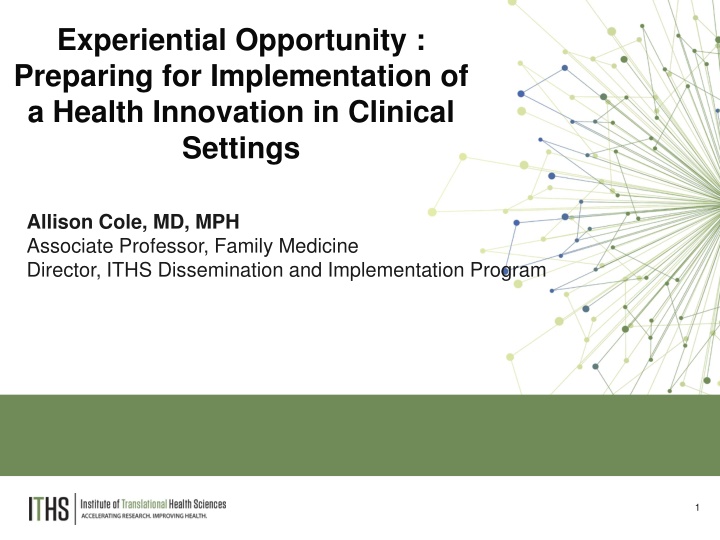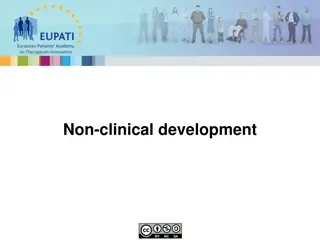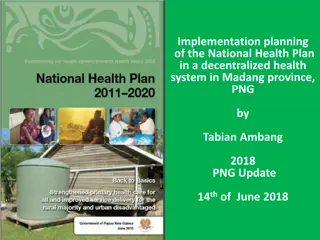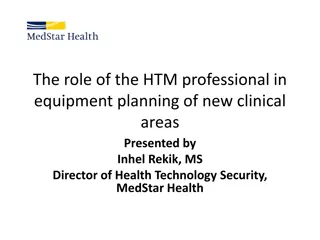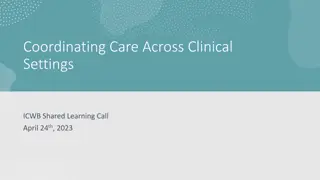Implementation Planning for Health Innovation in Clinical Settings
Dive into the experiential opportunity of preparing for the implementation of a health innovation in clinical settings with Allison Cole, MD, MPH. Explore options for operationalizing implementation and understanding your intervention. Engage in discussions on project progress, challenges, and next steps, including a capstone presentation. Utilize a modified Implementation Guide to plan for implementation by understanding your intervention and creating an action plan for implementation strategies.
Download Presentation

Please find below an Image/Link to download the presentation.
The content on the website is provided AS IS for your information and personal use only. It may not be sold, licensed, or shared on other websites without obtaining consent from the author.If you encounter any issues during the download, it is possible that the publisher has removed the file from their server.
You are allowed to download the files provided on this website for personal or commercial use, subject to the condition that they are used lawfully. All files are the property of their respective owners.
The content on the website is provided AS IS for your information and personal use only. It may not be sold, licensed, or shared on other websites without obtaining consent from the author.
E N D
Presentation Transcript
Experiential Opportunity : Preparing for Implementation of a Health Innovation in Clinical Settings Allison Cole, MD, MPH Associate Professor, Family Medicine Director, ITHS Dissemination and Implementation Program 1
Agenda Discuss progress to-date Capstone presentation Questions 2
Experiential Learning Options Option 1: Option 2: Operationalizing Implementation Understanding your Intervention Describe your intervention using Worksheet 1 Your Intervention Choose one foundational implementation strategy. Describe how you would use the implementation strategy using Worksheet 2 Action Plan
Discussion Project overview Which exercise you chose Progress-to-date What s been easy, what s been challenging What questions do you have Discussion 4
Next Steps Finish and finalize your exercise Capstone presentation on Feb 23 5 min presentation Capstone templates are located on Canvas under UCONJ 599 Please email Capstone PowerPoint slides to Milu Worku at mworku@uw.edu by February 19th Questions about Capstone presentation? Contact us with questions! We are available to meet via Zoom or on email. Please contact NAME/EMAIL 5
Implementation Planning Exercise Overview In this activity you will use a modified version of the Implementation Guide to learn about two important steps in the process of planning for implementation Understanding your intervention Creating an action plan for one implementation strategy that is appropriate for your intervention and clinical setting 6
Understanding your Intervention The first step in preparing for implementation is to carefully describe your intervention. This will help you identify the key personnel involved in your intervention and the expected activities and outcomes that will occur. Focus on the aspects of your intervention that are critical for its success. These are considered the intervention s core components. The Guide will guide you through a step-by-step process to examine your intervention 7
Understanding your Intervention - Overview Inputs resources needed to support the intervention. For example, staff, materials, training, existing clinical workflows, funding, equipment Activities components of the intervention itself. Activities include both actions to prepare for implementation (e.g. develop new clinical workflow) and actions for implementing and maintaining the intervention (e.g. administering the new treatment) Short term outcomes what you expect to occur as a result of the intervention activities. Short term outcomes may reflect modifications or changes in healthcare process (e.g., number of patients contacted) or healthcare service (e.g. number of tests performed) Long term outcomes anticipated health outcomes that will occur as a result of the intervention
EXAMPLE: Screening, Brief Intervention and Referral to Treatment (SBIRT) for Alcohol Use Disorder in Primary Care Settings Intervention characteristics Clinical staff to complete screening (medical assistant) Clinical staff to complete brief intervention and referral to treatment (clinician) Standard alcohol use disorder screening tool built into electronic health record Access to alcohol use disorder treatment Workflow to provide and track patient referrals Reimbursement for patient screening, counseling and referral Inputs resources needed to support the intervention o o o o o o Health IT team builds screening tool into electronic health record Medical assistants trained on screening Clinicians trained on brief intervention and referral Medical assistants screen, notify clinicians of abnormal screening results Clinicians provide brief intervention and referral Quality improvement leader assesses implementation success Activities components of the intervention itself. Activities include both actions to prepare for implementation and actions for implementing and maintaining the intervention Proportion of adult patients attending a visit that complete screening Proportion of adult patients with high-risk alcohol use Proportion of adults with high-risk alcohol use that receive brief intervention Proportion of adults with high-risk alcohol use that receive referral to treatment Proportion of adults with high-risk alcohol use that engage in treatment Short term outcomes what you expect to occur as a result of the intervention activities. Short term outcomes may reflect modifications or changes in healthcare process or healthcare service o o o o o Proportion of adults with high-risk alcohol use that reduce or abstain from alcohol Proportion of patients with medical complications related to alcohol use disorder Long term outcomes anticipated health outcomes that will occur as a result of the intervention
Overview of Implementation Strategies An implementation strategy is a method or technique used to enhance the adoption, implementation, and sustainability of a clinical program or practice. (Proctor EK, Powell BJ, McMillen JC 2013 https://doi.org/10.1186/1748-5908-8-139) There are some implementation strategies that appear to be foundational to implementing interventions in primary care clinical practice. They may be applicable to many clinical settings and across many types of interventions. 10
Foundational Implementation Strategies Throughout implementation, assess aspects of a practice or organization to determine its degree of readiness to implement the intervention Assess for readiness Assess various aspects of a practice or organization to identify barriers that may impede implementation Assess for the presence of barriers that may impede implementation Identify and respond to the culture of the practice or organization that you are working with (e.g. openness and communication, general leadership support and/or structure). Attend to Practice or Organization Culture Plan and conduct discussions that include providers or staff and address choosing and testing changes to support implementation of the intervention Conduct Local Planning Discussions Develop and support teams that are implementing the innovation. This can be accomplished through regular check-ins, which give the teams protected time to reflect on the implementation effort, share lessons learned, and support one another s learning Develop and Support Teams that are Implementing the Intervention Hold meetings targeted toward different stakeholder groups (e.g. providers, administrators, other practice or organizational stakeholders) to teach them about the intervention Conduct educational meetings Develop, test, or introduce quality monitoring tools and teach practices or organizations use of the quality monitoring tools. Develop or Implement Tools for Quality Monitoring
Creating an Action Plan Outline the elements of an implementation strategy you will use Who Who will deliver it What/How What are the actions or steps; how will it be carried out Target of the strategy Where or to whom is it direct or what is it trying to impact Goal or expected outcome Timing When in the project will it be used Frequency & Intensity How often and/or for how long will it be used 12
Action Plan: Strategy #1 for Implementation EXAMPLE Dimension & Description Strategy # 1 Audit and Provide Feedback Collect and summarize clinical performance data over a specified time period and give it to clinicians and administrators to monitor, evaluate, and modify provider behavior Health IT staff will collect Quality data (proportion of patients screened for alcohol use disorder, proportion of patients with a positive screen who received brief intervention and referral to treatment) from electronic health record Clinician champion will share performance reports with primary care teams (medical assistants and clinicians) Who delivers Which individual or individuals will deliver the implementation strategy? Strategies can have a single individual or multiple individuals involved The IT team will create monthly reports The performance reports will summarize performance by provider and be updated monthly The clinician champion will share the reports with clinical teams and provide best practices for improving outcomes Primary care teams Increased delivery of alcohol use disorder screening, brief intervention and referral to treatment by medical assistants and clinicians What/how How will the implementation strategy be delivered? What are the actions, steps or processes, and ordering of the steps? Target of the strategy Goal What is the goal or expected impact of the implementation strategy? Make sure the level of the goal is matched to the level of the implementation strategy. Reports will be shared starting in month two Timing When in the project will the implementation strategy be used? Reports will be shared monthly throughout the intervention period Frequency and Intensity How often and/or for how long will the implementation strategy be delivered?
Implementation Planning Exercise <PUT YOUR INTERVENTION HERE> <YOUR NAME, SCHOOL, DEPARTMENT> 14
<Name of your research product/s>: Intervention Characteristics INPUTS Resources needed to support the intervention <LIST INPUTS HERE>
<Name of your research product/s>: Intervention Characteristics ACTIVITIES Components of the intervention itself <LIST ACTIVITIES HERE>
<Name of your research product/s>: Intervention Characteristics SHORT TERM OUTCOMES what you expect to occur as a result of the intervention activities <LIST SHORT TERM OUTCOMES HERE>
<Name of your research product/s>: Intervention Characteristics LONG TERM OUTCOMES anticipated health outcomes that will occur as a result of the intervention <LIST LONG TERM OUTCOMES HERE>
<Name of your research product/s>: Implementation Strategy <Name and definition of implementation strategy you selected>
<Name of your research product/s>: Implementation Strategy Action Plan WHO WHAT/HOW TARGET OF STRATEGY GOAL TIMING FREQUENCY/INTENSITY
Thank You ITHS is supported by the National Center For Advancing Translational Sciences of the National Institutes of Health under Award Number UL1 TR002319. This project was supported by the National Center For Advancing Translational Sciences of the National Institutes of Health under Award Number TL1 TR002318. The content is solely the responsibility of the authors and does not necessarily represent the official views of the National Institutes of Health.
